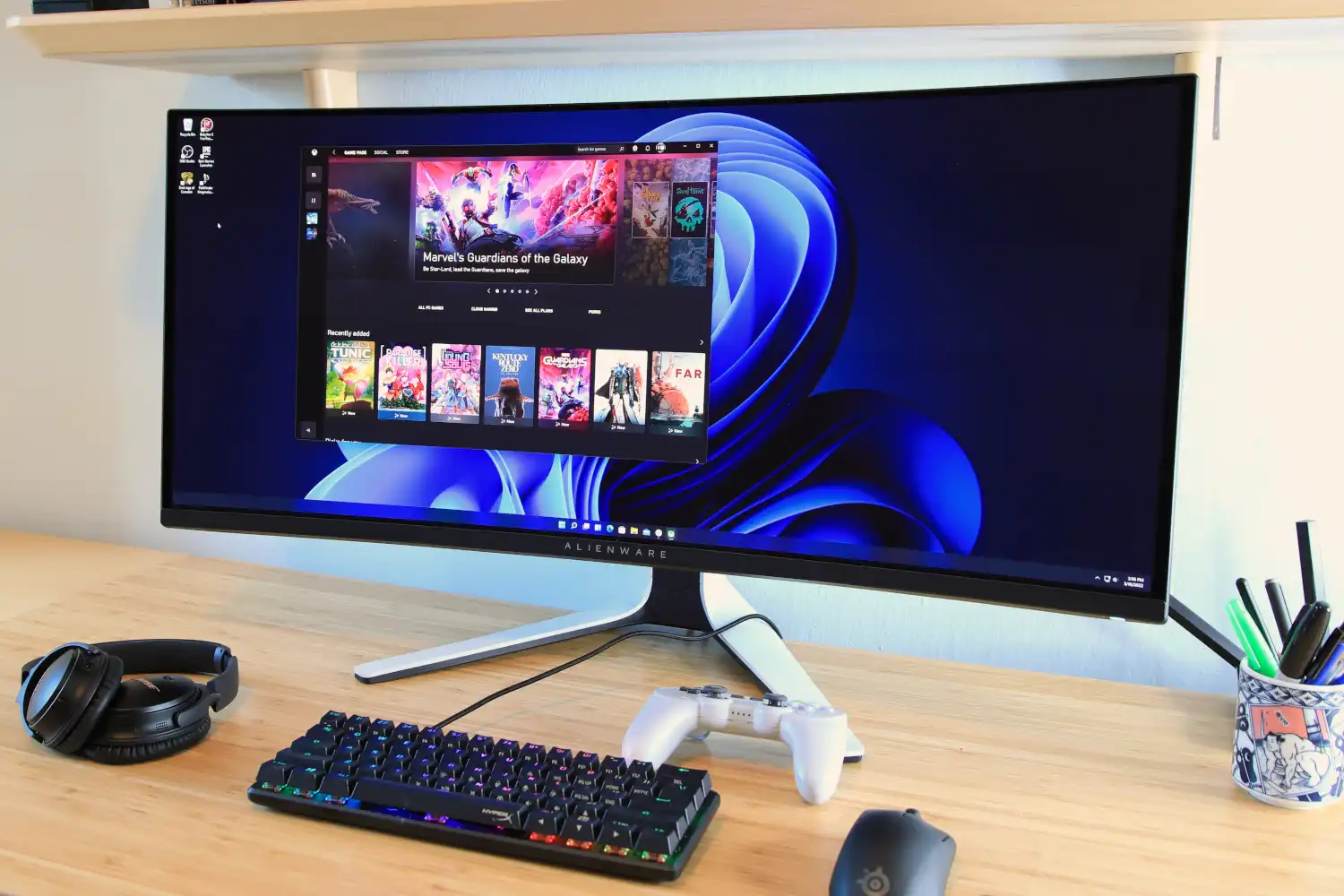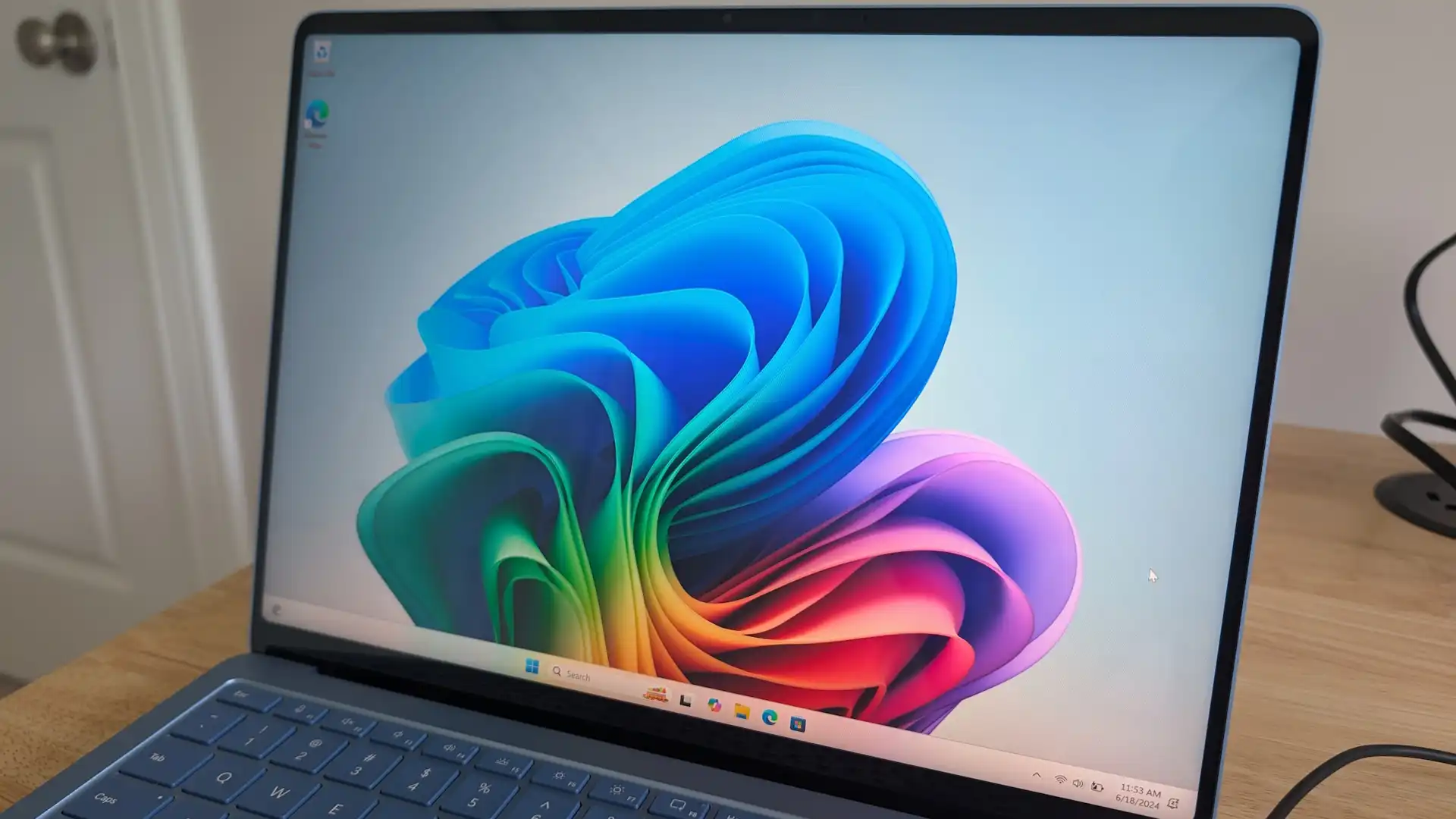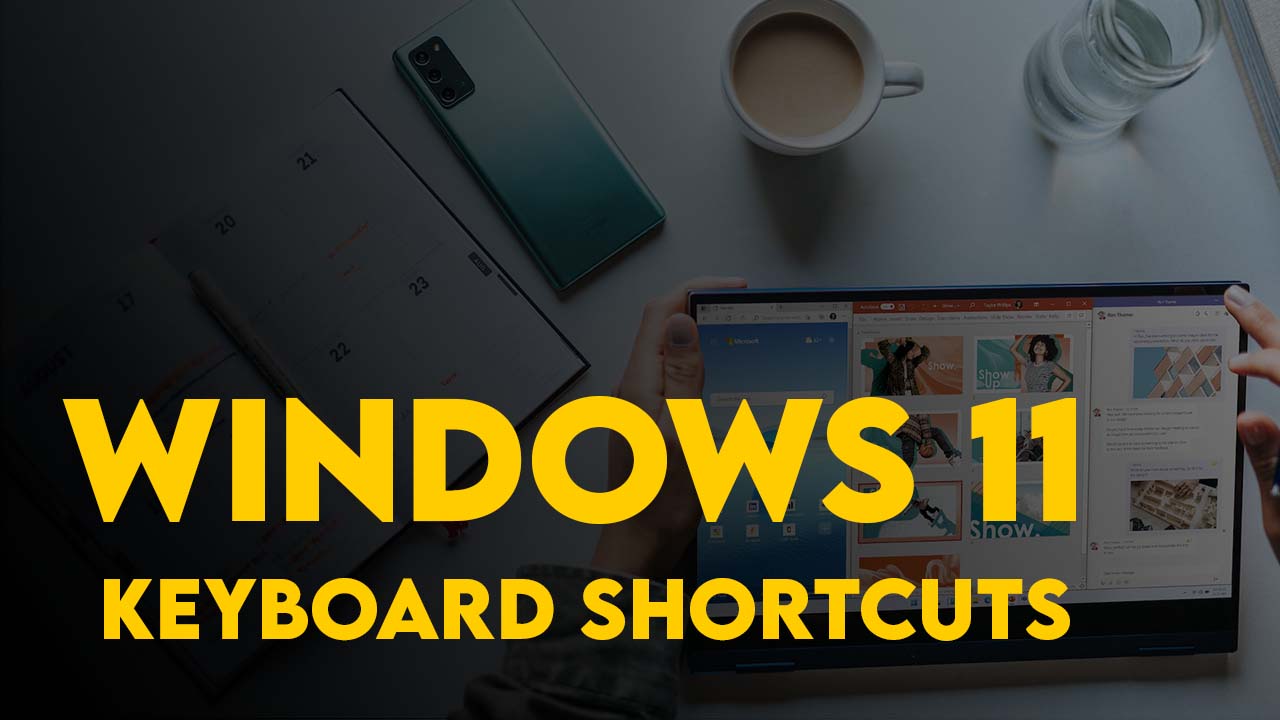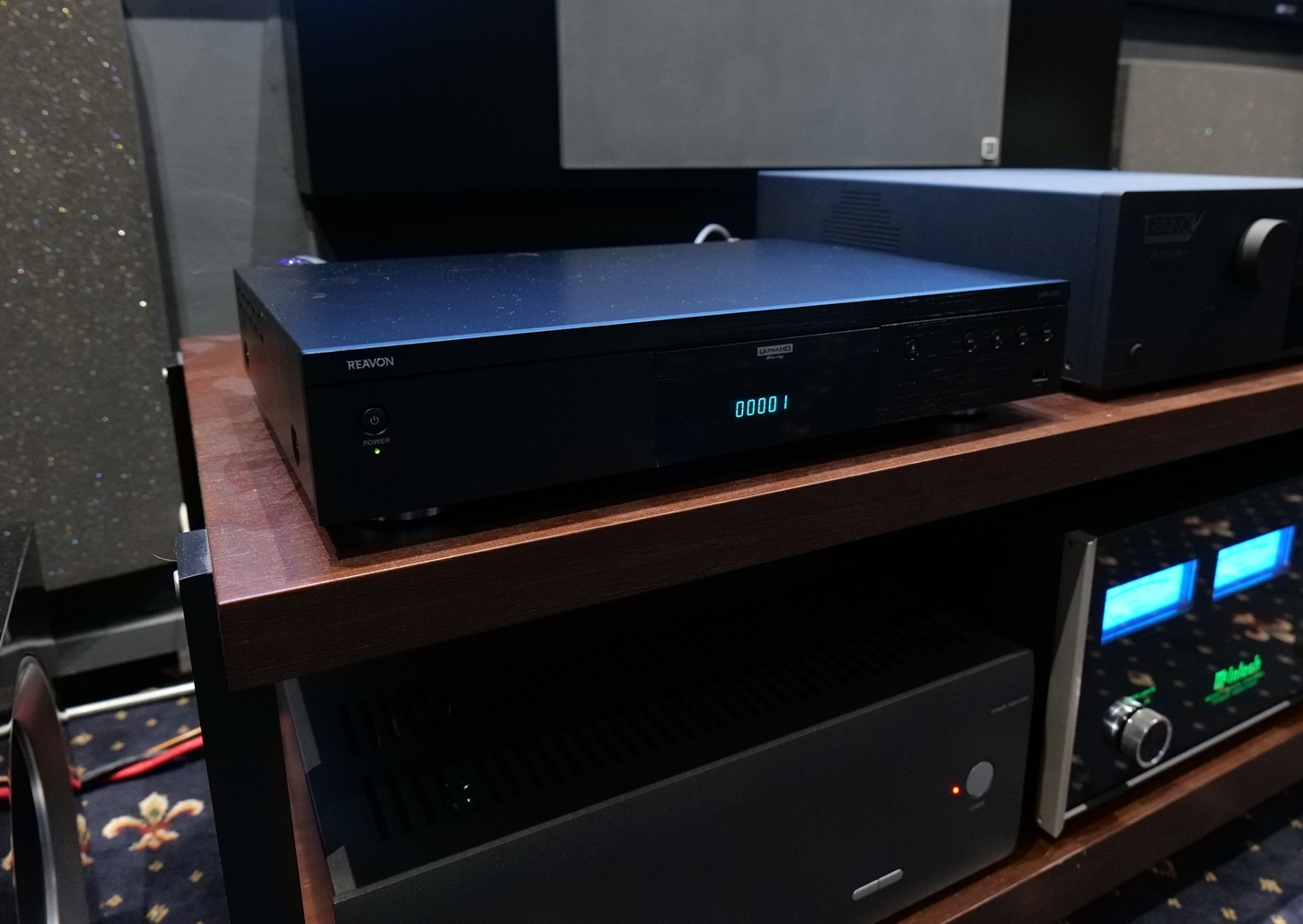Experience the difference a quality display makes.
Need a new monitor for your PC? We’ve combed through scores of options to find the best monitors on the market right now. Our picks are the result of hundreds of hours spent testing the latest models from Acer, Asus, BenQ, Dell, LG, Samsung, and other major brands.
While we feel that our favorite monitor overall is an awesome choice for most people, we also have alternative options for budget shoppers, gamers, and those seeking the best HDR performance. After all, not everyone needs the same features from a monitor. (If you’re looking specifically for a 4K monitor or gaming monitor, go check out our separate roundups highlighting your best options for those particular needs, as well.) You can find out more about how we evaluate monitors and what specs matter most below our list of recommendations.
Scroll below our recommendations to learn more about our monitor review process, or see our article on how we test monitors at PCWorld for even more details.
Dell Ultrasharp U2724DE – Best monitor overall
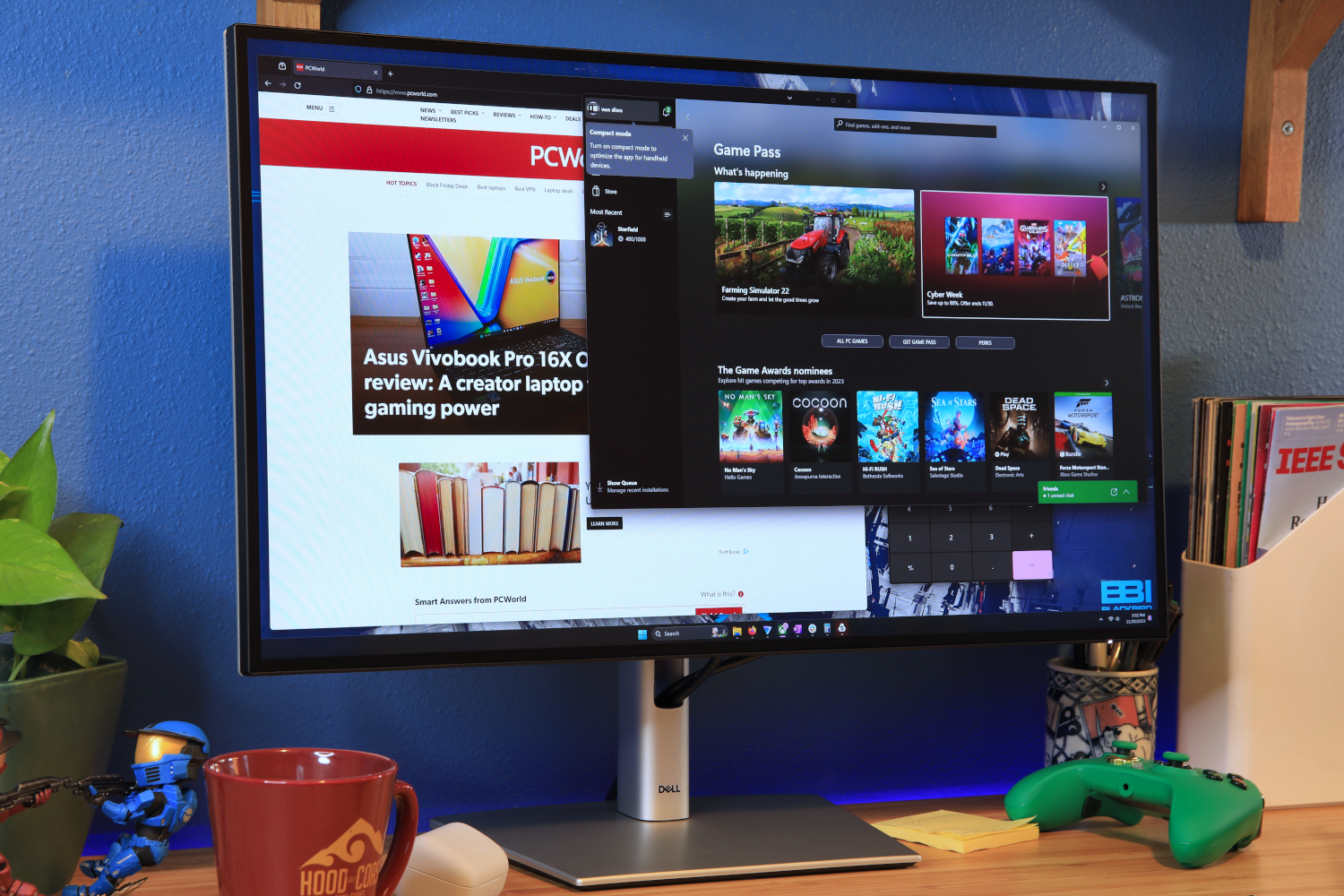
Pros
- Attractive and functional design
- Class-leading Thunderbolt and USB connectivity
- IPS Black improves contrast
- 120Hz refresh rate
Cons
- Most competitors offer 4K resolution
- No HDR support
- Adaptive sync has some caveats
Dell’s Ultrasharp U2724DE is arguably the most versatile monitor ever sold. It’s great for home office productivity, good for gaming, and can handle more serious content creation workflows, like photo and video editing.
The U2724DE has an IPS Black panel that roughly doubles the monitor’s contrast ratio (compared to other IPS monitors). It can’t beat a more expensive OLED or Mini-LED panel, but it’s still alluring. It also lacks the burn-in worries of OLED which, although unlikely to occur in mixed use, might become an issue if you spend all day working in Excel and plan to keep your monitor for as long as possible.
Dell pairs the IPS Black panel with an enhanced 120Hz refresh rate. Upping the refresh rate greatly improves motion clarity and makes the U2724DE a viable display for gamers. That’s a big deal. It means you can buy one monitor for both work and play.
The U2724DE goes all-in on connectivity. Thunderbolt 4, USB-C, USB-A, DisplayPort-in and -out, and HDMI are present. It even has a 2.5G Ethernet port. These features are ideal if you plan to connect a laptop over USB-C, as the U2724DE will greatly expand the laptop’s connectivity.
Resolution is the only notable downside. The U2724DE is a 1440p monitor, while many competitors in its price bracket offer 4K. This is the trade-off made to hit monitor’s 120Hz refresh rate. Those who prefer 4K should consider the Dell Ultrasharp U2723QE, which also has an IPS Black panel and extensive connectivity. Shoppers on the budget, meanwhile, can consider the U2724D. It’s nearly identical to the U2724DE but reduces the available ports to hit a lower price.
Pixio PX248 Wave – Best budget monitor

Pros
- Attractive design, especially in unique colorways
- Built-in speakers are surprisingly decent
- Solid color accuracy and respectable gamut
- Good motion clarity
Cons
- Array
The Pixio PX248 Wave stands out as an excellent budget monitor for a wide range of shoppers. At $150, this 24-inch 1080p display delivers on both value and image quality. It’s also available in several colors to fit your personal desk setup.
The monitor’s 200Hz refresh rate and good motion clarity benefit both gamers and general users who appreciate smooth visuals. If you just need a monitor for office productivity, however, its solid color accuracy and reasonable contrast will prove more than up to the task. Though far from the most dazzling display, the Pixio PX248 Wave’s overall image quality is great for the price.
Available in unique colors like pink and blue, as well as black and white, the PX248 Wave will fit in any home office or gaming den. It also has practical extras like decent built-in speakers and Adaptive Sync support for smooth, tear-free gameplay. It has some limitations, like a basic stand, but Pixio sells an optional color-coordinating monitor arm. It’s a good purchase if you want to improve the monitor’s ergonomics.
It’s certainly possible to buy a monitor for less than the Pixio PX248 Wave, but its strong feature set and low price can make that tough to justify. Dipping to more basic displays, which are often just $20 or $30 less, will leave you with a much less functional monitor and noticeably inferior image quality. That’s why the PX248 Wave is our go-to budget pick.
Read our full Pixio PX248 Wave review
Dell S2722QC – Best budget 4K monitor

Pros
- Uniquely affordable USB-C monitor
- 4K resolution with HDR option
- High brightness and good color accuracy
- Integrated speakers
Cons
- Low contrast ratio saps SDR vibrance
- Mediocre color gamut
The Dell S2722QC is the best budget 4K monitor you can buy right now. Initially priced at $380, the monitor can now be found for as low as $250. It stands among other budget offering by combining 4K resolution and USB-C connectivity typically reserved for more expensive models.
Dell’s 27-inch IPS display is suitable for most lighting conditions, with crisp visuals and a respectable brightness of 296 nits. In addition to its sharp 4K image, the monitor delivers color performance that can easily handle everyday productivity, streaming, and light gaming. A USB-C port with 65 watts of USB Power Delivery for charging a connected laptop or tablet, as well as two USB-A ports for connecting wiring peripherals make it very versatile. The monitor even ships with a sturdy yet compact ergonomic stand that adjusts for height, tilt, swivel, and pivot.
Naturally, the Dell S2722QC makes some compromises to keep the price low. The IPS panel’s contrast ratio is low, which can make the image look flat and dull when playing games or watching a movie. Think of it as more of a home office monitor than the centerpiece of a gaming setup. After all, quality 4K gaming monitors are usually more expensive.
All in all, the Dell S2722QC’s combination of 4K resolution, USB-C connectivity, and affordability makes it a solid choice if you want a tack-sharp home office monitor at a low price.
Read our full Dell S2722QC review
Dell G2724D – Best budget gaming monitor
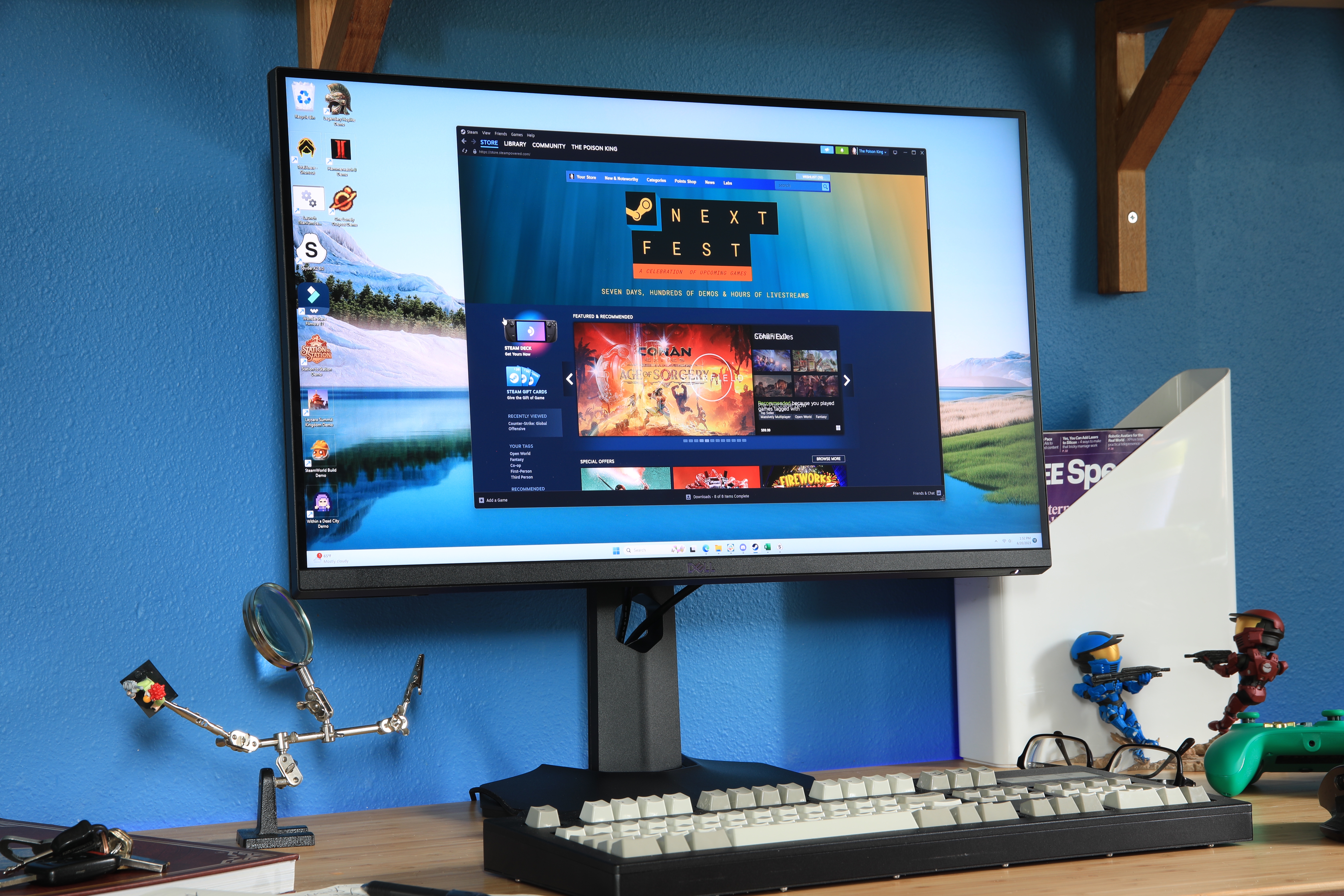
Pros
- Handsome design with functional stand
- Attractive SDR image quality
- Good motion clarity at 165Hz
- Supports all Adaptive Sync standards
Cons
- No USB connectivity or 3.5mm audio-out
- Lackluster HDR
Dell’s G2724D hits the sweet spot for gamers on a budget who also care deeply about quality.
The 27-inch IPS LCD panel features 1440p resolution and a refresh rate of 165Hz. The color gamut spans 100 percent of sRGB, 86 percent of DCI-P3, and 82 percent of Adobe RGB, ensuring a bright and vibrant image that’s not only excellent in games but serviceable for most content creation. But its standout feature is the Adaptive Sync support, with official support for VESA Adaptive Sync, AMD FreeSync Premium, and Nvidia G-Sync.
Despite its affordable price, the monitor doesn’t skimp on design, with a handsome matte black and gray chassis and sporty rear vents that provide an aggressive yet unobtrusive look. It also comes with a functional monitor stand that offers a range of ergonomic adjustments and a compact base that doesn’t take up unnecessary desktop space.
The monitor doesn’t offer USB connectivity or 3.5mm audio-out. Also, the HDR performance is a bit lackluster, so those who require HDR gaming may want to look at other options.
But it’s hard to beat the G2724D’s performance at $200 or below and, more importantly, it offers everything an average PC gamer is going to need for smooth and responsive gaming. All told, it offers excellent value, and could have a place on your desk for five to 10 years.
If you want to save even more money, check out the Pixio PX248 Wave. It’s a step down from the G2724D, but still surprisingly solid at less than $150 — nice design, decent built-in speakers, up to 200Hz refresh rate, adaptive sync, and good performance.
Read our full Dell G2724D review
Alienware AW3423DWF – Best gaming monitor
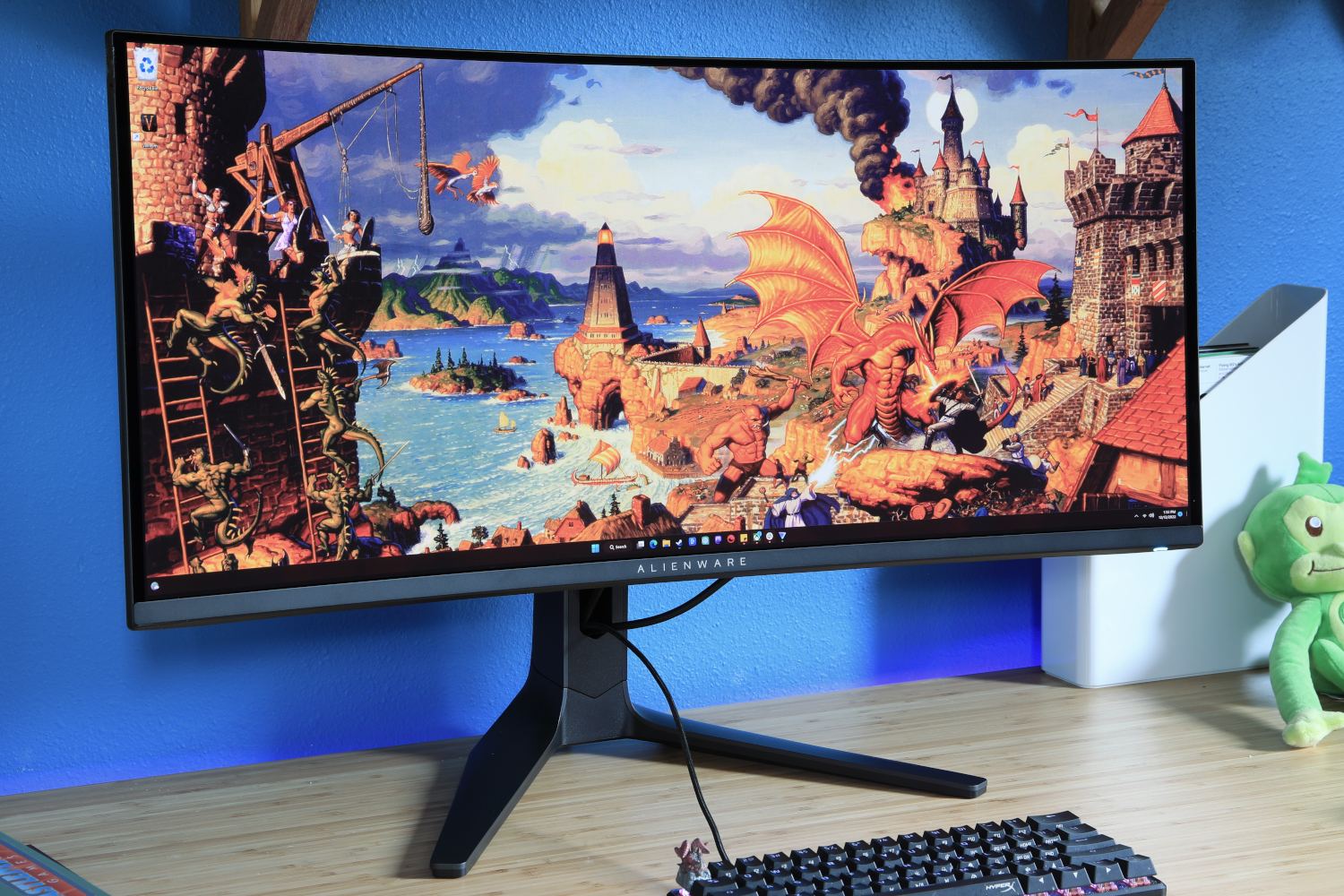
Pros
- Excellent contrast ratio
- Top-notch color gamut and accuracy
- Great motion clarity
- Respectable HDR performance
- Extremely competitive price
Cons
- Stand is a bit too large
- No USB-C
- Maximum HDR brightness is lackluster
Alienware’s AW3423DWF is an outstanding PC gaming monitor.
This monitor has a QD-OLED panel, which is like that used in top-tier OLED televisions. OLED provides a nearly infinite contrast ratio, excellent color performance, and respectable brightness. The result is a punchy, vibrant image with an unparalleled sense of dimensionality. The monitor’s ultrawide aspect ratio only heightens the sense of immersion.
Motion clarity is superb. The monitor has a refresh up to 165Hz and supports both AMD FreeSync Premium Pro and VESA Adaptive Sync. The OLED panel technology it uses has lower pixel response times than competitors, too, so there’s minimal added blur and ghosting in motion. Motion is as crisp as you’ll find below 240Hz.
The Alienware AW3423DWF is an alternative to the AW3423DW, a slightly older and nearly identical monitor. The AW3423DW has a higher fresh rate of 175Hz and supports Nvidia G-Sync Ultimate. It’s also $100 to $200 more expensive. Though we recommend the AW3423DWF for most people, the AW3423DW is better for owners of high-end Nvidia graphics cards.
The AW3423DWF is expensive at $1,099.99, but its performance justifies the price. Competing 34-inch and 38-inch ultrawides without QD-OLED technology are often just as expensive but have less impressive image quality.
Read our full Alienware AW3423DWF review
Innocn 27M2V – Best budget HDR monitor

Pros
- Excellent color gamut and accuracy
- Sharp, vivid picture
- Strong HDR performance
- Good connectivity
Cons
- Design looks nice, but feels inexpensive
- Thin user manual
- Confusing on-screen menu
You likely haven’t heard of Innocn—but if you want a great HDR monitor on a slim budget, the Innocn 27M2V should be on your short list.
The Innocn 27M2V is a 4K Mini-LED monitor with a maximum refresh rate of 160Hz. It hits an impressive maximum measured HDR brightness of 877 nits, which is enough to deliver a gut-punch of detailed luminance in vibrant HDR scenes. The 27M2V outperforms OLED and LED edge-lit monitors.
And it’s no one-trick pony. The 27M2V has accurate and vivid color, immersive contrast, and crystal-clear sharpness. It can’t defeat OLED monitors like the Alienware AW3423DW in SDR content, but it’s closer than you’d think.
The 27M2V provides strong connectivity, too. It includes a USB-C port with 90 watts of Power Delivery for charging external devices. That’s flanked by one DisplayPort and two HDMI 2.0 ports, for a total of four video inputs.
What’s the catch? The monitor’s design, although reasonably attractive, feels inexpensive when handled. The on-screen menus are confusing, a problem worsened by the lack of a quality user manual. And customer support can only be reached by email.
Fortunately, these issues are reduced by excellent pricing. The Innocn 27M2V has a retail MSRP of $799.99 on Amazon, but frequently goes on sale for as little as $679.99. It’s fantastic value at either price.
Read our full Innocn 27M2V review
Philips Creator Series 27E2F7901 – Best home office monitor

Pros
- IPS Black panel improves contrast ratio
- Excellent color gamut and accuracy
- Sharp 4K image
- USB-C connectivity with Power Delivery, DisplayPort-Out
Cons
- Generic design
- Awkward on-screen menu system
- Lackluster HDR, 60Hz refresh rate
Philips’ Creator Series 27E2F7901 is the ideal monitor for your home office. It features a 27-inch display with IPS Black panel technology, tons of useful connectivity, and top-notch image quality.
Its IPS Black display panel is a rather new technology that significantly enhances the contrast ratio compared to older IPS monitors, which results in a deeper, more immersive image. Its color gamut and accuracy are commendable, too, and its 4K resolution means web pages, photos, and PDFs all look razor-sharp.
Connectivity is another big strength. The 27E2F7901 accepts video over HDMI, DisplayPort, and USB-C, with the latter also serving as a USB hub for multiple downstream USB ports. The USB-C port is also capable of charging devices that require up to 96 watts of power. It has DisplayPort-Out, as well, an uncommon connection that can connect a second monitor directly to the Philips.
While the monitor’s design is not as attractive as Dell’s Ultrasharp series, it still retains the features most people need. It comes with an ergonomic stand that adjusts for height, tilt, swivel, and pivot. The monitor also has an adapter for use with 100x100mm VESA mounts, making third-party monitor arms and stands an option.
Though excellent, the 27E2F7901 isn’t perfect. The on-screen menu system can be awkward to navigate. Also, while HDR is supported, the monitor’s HDR performance is underwhelming. And its humble 60Hz refresh rate will disappoint gamers.
These downsides are not uncommon as many competitors also have them. Due to the Philip’s pricing however, these can be forgiven—the 27E2F7901 retails for just $499.99. Though not inexpensive, it undercuts similar home office monitors from Dell and LG by roughly $100. Overall it provides exemplary value by delivering top-tier connectivity and image quality for an excellent price.
Read our full Philips Creator Series 27E2F7901 review
Viewsonic ColorPro VP16 OLED – Best portable monitor
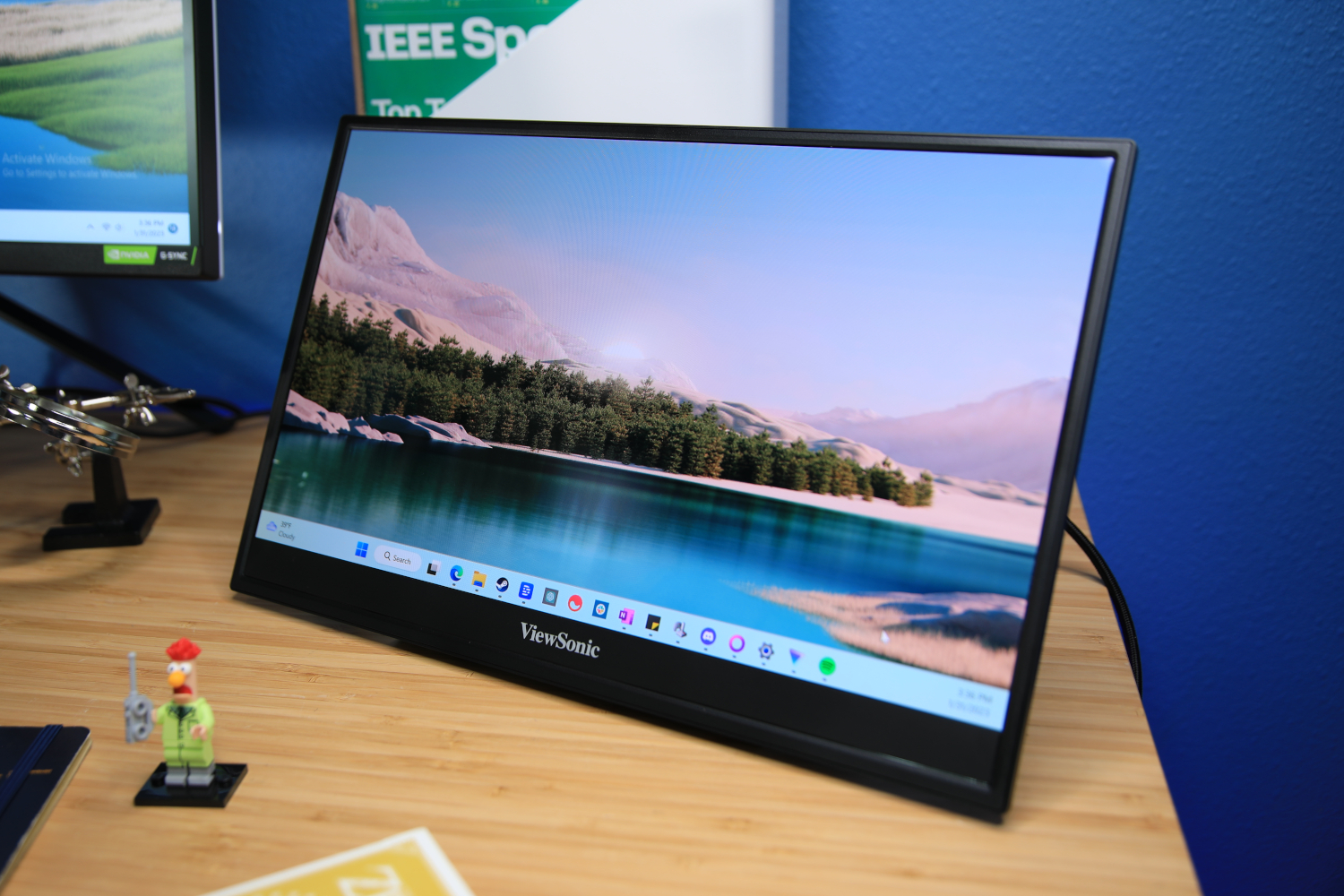
Pros
- Versatile, useful stands
- Good connectivity, cables included
- Numerous image quality customization options
- Top-tier image quality even at default settings
Cons
- Speakers are included, but weak
- Pricey for a portable monitor
- No HDR
The Viewsonic VP16-OLED is an impressive portable OLED monitor that combines class-leading image quality with a unique and useful stand.
As its name suggests, the VP16-OLED has a 15.6-inch OLED panel with 1080p resolution. It delivers outstanding image quality, scoring top marks in color accuracy, gamut, and contrast. The VP16-OLED’s performance is superior to many full-sized OLED monitors—and completely smashes portable competitors. This makes the VP16-OLED ideal for photographers, videographers, and other content creators.
The monitor has a versatile stand. It can be used as a kickstand, as is true of most portable monitors, or expand to hold the monitor upright. The stand includes two USB-C ports, either of which can be used to provide power and video input to the monitor. It also offers a micro-HDMI port for use with devices that lack USB-C. Viewsonic bundles the monitor with several cable types and a USB-C power brick, so you don’t have to buy additional adapter cables or accessories.
There’s just one problem: It’s expensive. The Viewsonic VP16-OLED retails at $399.99, more than double the price of a basic 1080p portable monitor. That’s tough to justify if you just need a second monitor to display Slack and Twitter, but it’s a worthwhile upgrade if you care about image quality.
Read our full Viewsonic ColorPro VP16-OLED review
Asus ProArt Display OLED PA32DC – Best monitor for professionals
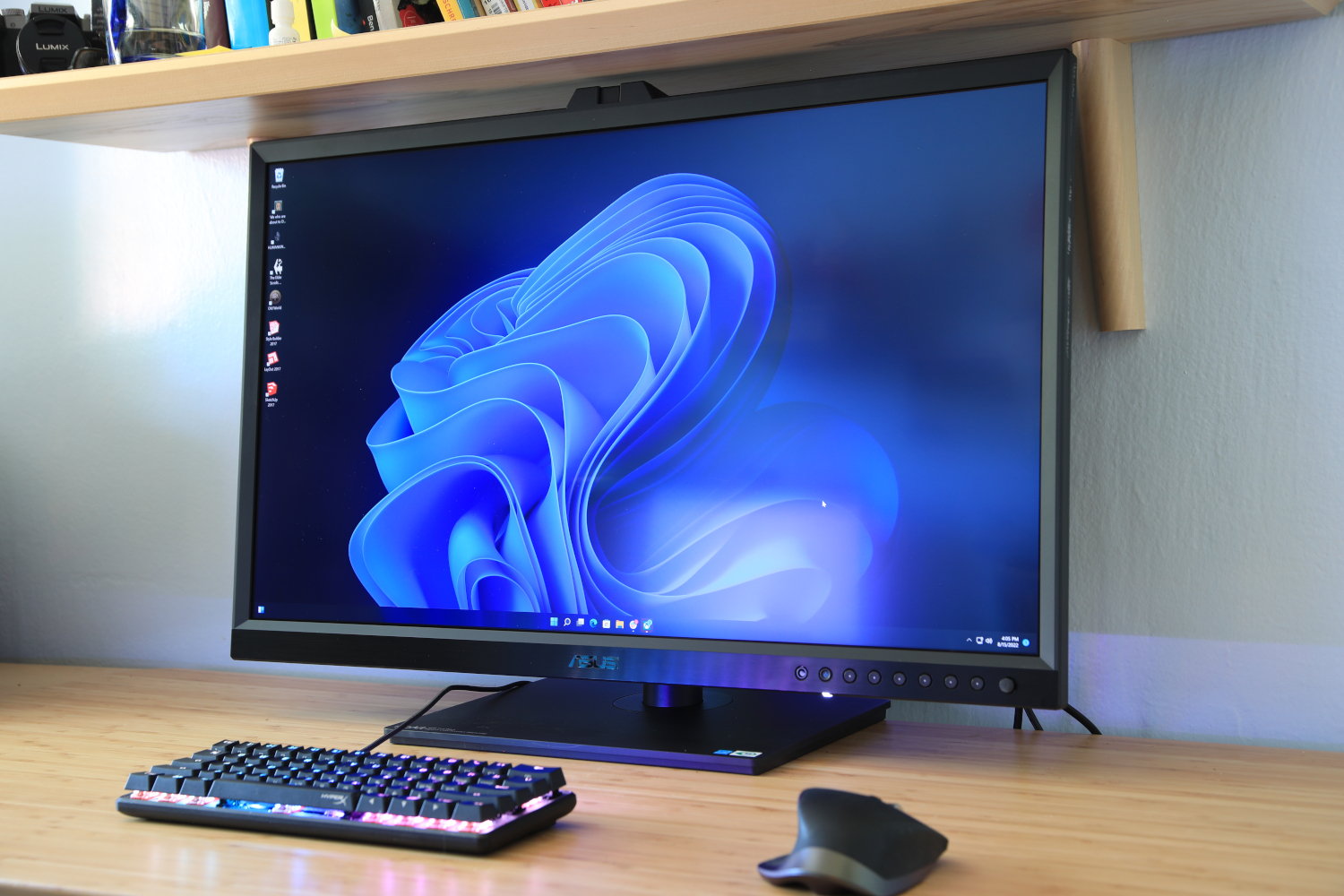
Pros
- The best SDR image quality yet
- Good HDR performance
- Long list of image quality features
- Exceptionally sturdy
- Numerous inputs, plus USB hub
Cons
- HDR brightness could be better
- Glare can be an issue in bright rooms
- Only 60Hz, no adaptive sync
Do you need a monitor with exceptional color accuracy, contrast, and sharpness? The Asus ProArt Display OLED PA32DC delivers. It’s an impressive monitor that, in several respects, is the best we’ve ever reviewed.
The monitor’s key trait is its high-quality OLED display panel. It has excellent contrast, color accuracy, and a wide color gamut, all of which add up to a realistic and dramatic image. The monitor also has 4K resolution and a conventional RGB subpixel layout, which avoids the color fringing issues that are found in QD-OLED monitors like the Alienware AW3423DW.
Image quality is superb out of the box, but experienced owners can go a step further. The PA32DC has numerous image quality options in its on-screen menu system and includes a built-in calibration utility for ultra-accurate results. Professionals can use these options to achieve the exact results their work requires.
It’s a wonderfully robust monitor with chunky bezels, big menu buttons, and a sturdy chassis that includes a built-in handle. Asus supplies both a VESA stand for desktop use and flip-out legs for quick setup at a mobile studio or job site. The monitor has extensive connectivity including five video inputs.
The only downside? It’s expensive with a retail price of $3,000. Even that, however, is not so bad: Similar OLED and Mini-LED monitors, like the Apple Pro Display XDR and LG UltraFine 32EP950, are often even more expensive.
Read our full Asus ProArt OLED PA32DC review
BenQ SW242Q – Best 16:10 aspect-ratio monitor
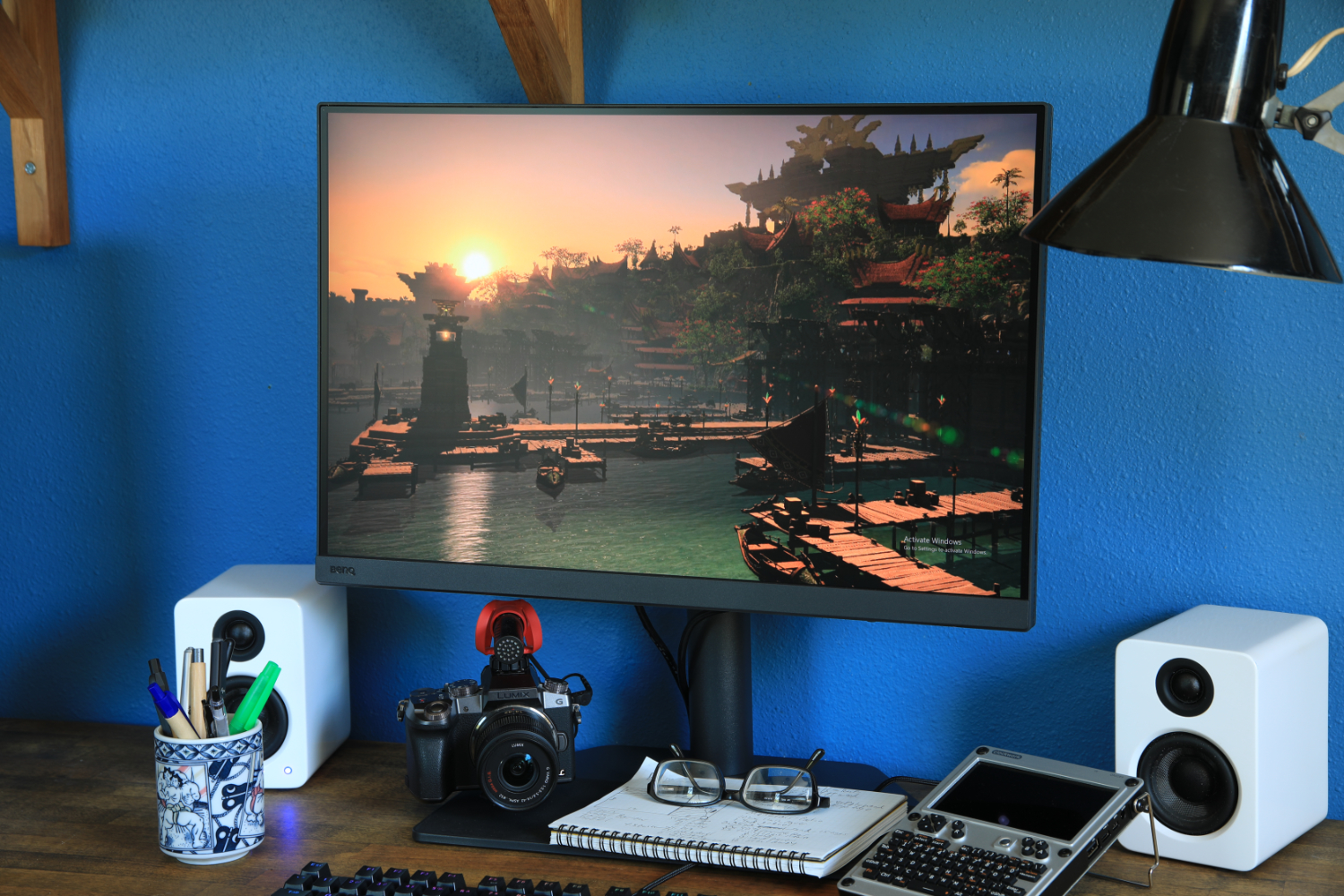
Pros
- Sturdy professional design
- 16:10 aspect ratio, 1600p resolution
- Excellent color performance
- Wide range of connectivity
Cons
- $480 for 24-inch monitor
- Low contrast ratio
- Disappointing motion clarity, no adaptive sync
The BenQ SW242Q sets itself apart in a crowded market with its 16:10 aspect ratio and 2560×1600 resolution. Its aspect ratio, which is closer to square than the more typical 16:9, provides additional vertical space for creatives, and its resolution beats most competitive 24-inch monitors.
Designed for professionals, the SW242Q is encased in a sturdy, charcoal black frame and supported by a robust stand that offers adjustments for height, tilt, swivel, and pivot. The stand’s deep and wide base is flat and covered in a luxurious material. Connectivity options include HDMI, DisplayPort, USB-C with 90 watts of USB Power Delivery, and an SD card reader.
Where the SW242Q truly excels is its color performance. It boasts an impressive color gamut that covers most of the DCI-P3 and AdobeRGB spaces, which is essential for accurate photo and image editing. The monitor’s color accuracy is bolstered by its low color error and “fine-coated” panel, which is designed to emulate the look and texture of a printed material.
The BenQ SW242Q is not without compromise. It has a low measured contrast ratio of 980:1, which reduces the depth and richness of movie and games. Its 60Hz refresh rate and lack of Adaptive Sync underscore its focus on static content over motion clarity. And with a price tag at $480, the monitor’s cost may be hard to justify for some.
Creative professionals seeking top-notch color accuracy and a 16:10 aspect ratio, however, are likely willing to pay a high price for the monitor’s strengths. It’s the best, most feature-rich 16:10 monitor available right now.
Read our full BenQ SW242Q review
Acer Predator CG48 – Best television alternative
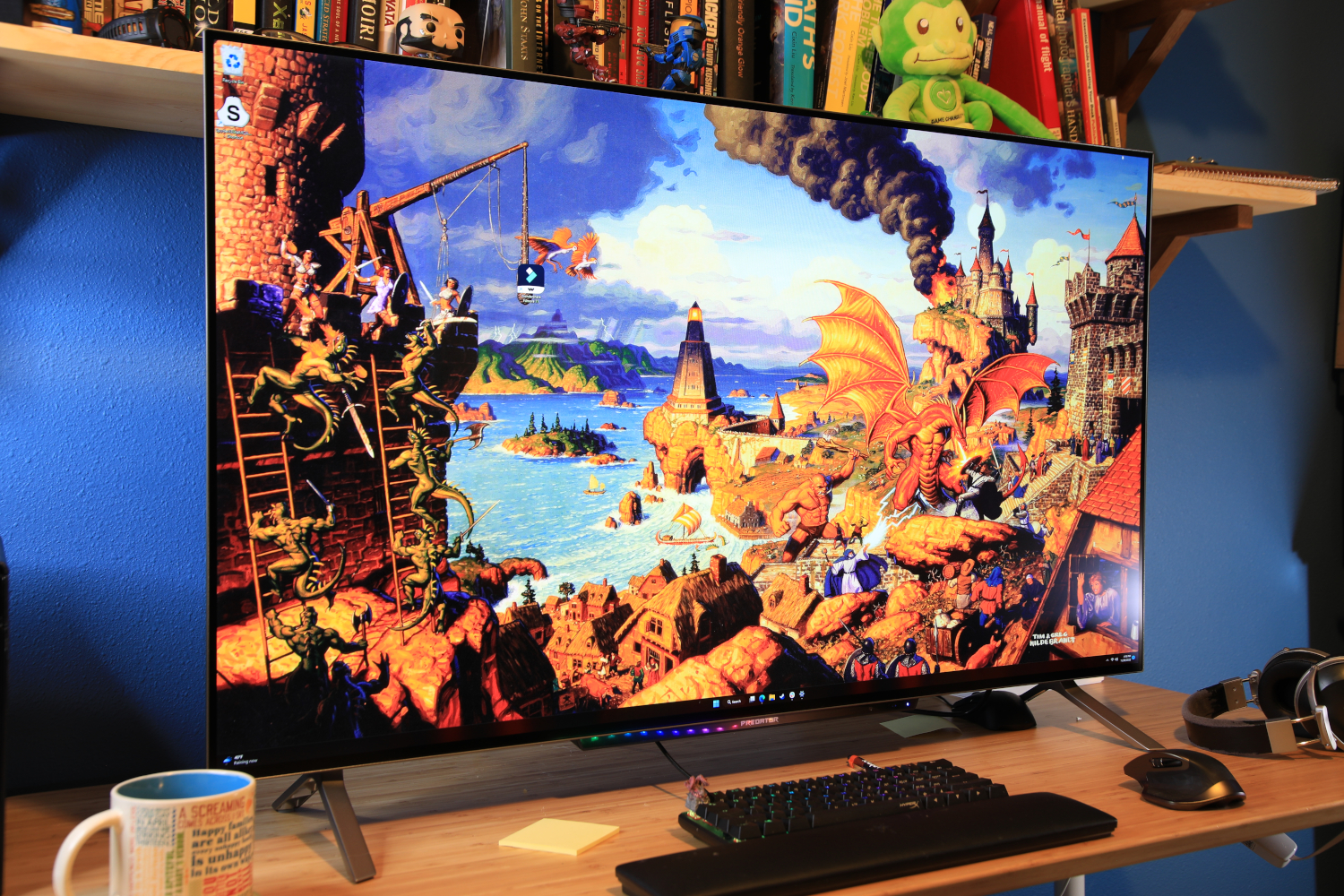
Pros
- Excellent SDR, strong HDR image
- Great motion clarity
- Superior contrast and wide color gamut
- Multiple PC-friendly connections including USB-C hub
- Useful bundled remote
Cons
- Only one HDMI 2.1 input
- Sharpness is just ok
- Stand offers no adjustment, no VESA mount
Want a massive display, but don’t want to deal with the “smart” features and limited PC connectivity of a television? Acer’s Predator CG48 is an excellent choice.
This 48-inch OLED monitor delivers 4K resolution and a refresh rate up to 138Hz. It offers an outstanding picture straight out of the box with spot-on color accuracy, excellent contrast, and a wide color gamut. It also has excellent viewing angles and, of course, a large display area that’s ideal for a large office or small home entertainment center. The monitor’s maximum brightness could be higher, but it still looks good in HDR content, especially when used in a dark room.
Though similar in size to some OLED televisions, the Acer Predator CG48 is not a TV. It doesn’t have a TV tuner and can’t connect to a coaxial antenna or cable connection. PC connectivity is superb, though, with DisplayPort, USB-C, and HDMI 2.1 available, as well as three additional HDMI 2.0 ports.
A remote is included and can be used to navigate the monitor’s on-screen menu. Acer provides a wide range of image quality adjustments that make it easy to customize the image to your liking. The monitor’s out-of-box performance was excellent, too, and worked well with both PC and game console inputs.
The Acer Predator CG48 carries a MSRP of $1,499.99, which is high. It’s often on sale, so it’s wise to shop around. Buying the monitor at a discount can save you hundreds.
Read our full Acer Predator CG48 review
What to look for in a monitor
There are literally hundreds—and perhaps thousands—of monitors to choose from. Choosing one from the crowd can be difficult, but knowing the key traits of a monitor will help you make your decision.
Resolution
Most monitors are available in 4K (3,840×2,160), 1440p (2,560×1,440) and 1080p (1,920×1,080) resolution. A higher resolution provides a sharper, more attractive image and is generally preferable. There’s nothing wrong with 1080p, however. It remains the baseline and is by far the most popular resolution sold today.
Connectivity
Look for a monitor with a connection supported by your computer. HDMI and DisplayPort are the most common. USB-C is rising in popularity because it can charge connected devices, such as a laptop.
Refresh rate
Most monitors have a 60Hz refresh rate, but a higher refresh rate (such as 144Hz) will make motion look smooth and crisp. This is most appealing to PC gamers, as improved motion performance is most noticeable when panning the camera in a 3D game.
Adaptive sync
This technology also improves motion performance. It does so by keeping a monitor’s refresh rate in sync with the video input from your computer. Our guide to FreeSync and G-Sync provides more detail.
HDR
Many 4K monitors support HDR, but often the HDR performance is lackluster. The HDR will function, and may look superior to SDR, but it won’t approach the quality implied by the spec. To ensure a quality HDR experience, look for a minimum of VESA DisplayHDR 1000 certification (or VESA DisplayHDR True Black). See our article on everything you need to know about HDR on your PC to learn more.
Want to know more before you make a decision? Our monitor buying guide explains the nerdy details of monitor specifications.
How we test monitors
Our monitor guides are based on testing by freelance and staff contributors with decades of combined experience.
While we rely on our eyes for an initial impression, we thoroughly test each monitor with a Datacolor Spyder X2 Ultra color calibration tool. This specialized hardware can objectively measure a monitor’s brightness, contrast, color gamut, color accuracy, luminance and color uniformity, gamma, and many other aspects of image quality.
Using this tool helps us detect strengths and weaknesses that don’t stand out at a glance and guarantees that a change in lighting conditions or monitor location won’t skew our impression.

